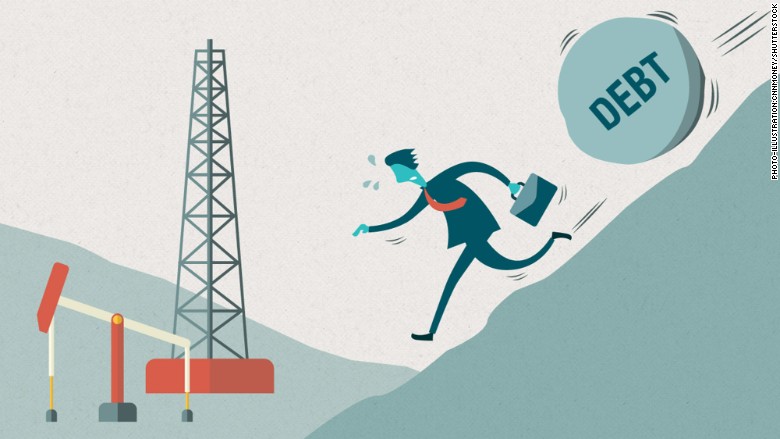
American oil companies are drowning in a sea of red ink.
The crash in crude oil prices caused a stunning $67 billion in combined losses by 40 publicly-traded U.S. oil producers last year, according Energy Information Administration research. And the bleeding is expected to continue at least early this year for many.
The losses surpassed $1 billion each from struggling oil companies like EOG Resources (EOG), Devon Energy (DVN) and Linn Energy (LINE) as well as SandRidge Energy (SD), the shale oil driller that recently admitted it's exploring a bankruptcy filing.
The EIA research excluded some of the largest oil companies such as ExxonMobil (XOM) and Chevron (CVX), both of which posted profits last year, albeit vastly smaller in size. These companies were excluded because they also have large offshore operations and the EIA report focused on on-shore oil companies.
The analysis also revealed that the companies most vulnerable to losses were oil producers with too much debt taken on during the boom years. The 18 U.S. oil companies that reported the biggest losses were saddled with $57 billion in long-term debt. These big losers also had an alarming average long-term debt-to-equity ratio of 99%, the EIA said.
By comparison, the remaining 22 companies that posted milder losses had total debt of $40 billion, or 58% of equity.
Related: Toxic oil loans create trouble for big banks
Companies with lots of debt have a much smaller margin for error. When cash flows dry up, as they have since oil prices started to crash in mid-2014, it makes it more difficult to make interest payments on their debt.
Secondly, these companies are more likely to have borrowed the money to make risky explorations or expanded into oilfields that are unprofitable. That can backfire when prices drop, forcing them to write down the value of those suddenly unprofitable assets.
"It seems those companies that were most highly leveraged were also the ones taking the riskiest bets. That's what has come back to hurt them the most," said Matt Smith, director of commodity research at ClipperData.

In fact, the high debt group of companies wrote down reserves by 21% last year, compared with a more modest 6% reduction by the other group, EIA said.
Even though oil prices have rebounded from $26 a barrel in February to above $42 today, oil companies are still under significant financial pressure. Wall Street is bracing for more losses this earnings season from oil drillers like Continental Resource (CLR)s, Diamondback Energy (FANG) and Denbury Resources (DNR).
And get ready for more red ink from SandRidge Energy, the Oklahoma City shale oil driller saddled with $3.6 billion of debt. SandRidge warned last month it could be forced into bankruptcy, potentially making it the biggest North American oil-focused company to go bust during the current downturn.
Related: BP profits crash by 80%
Against this challenging backdrop, the oil industry is wrapping up a difficult process with bankers known as "redetermination." Under this process, bankers can reduce or even yank their credit lines to oil producers.
The EIA warned that oil companies with "high leverage or lower quality assets could face significant curtailment" of their access to short-term credit. That in turn could constrain their ability to drill for oil or even lead to bankruptcy.
But so far bankers haven't been too tough on their oil clients -- and they're likely to be encouraged by the recent oil price rebound. For example, Chesapeake Energy (CHK) recently eased fears of a catastrophic cash crunch by reaching a deal with its banks to keep a $4 billion credit line.
"Even though there have been huge losses, it seems the period of panic is over," said Smith.


